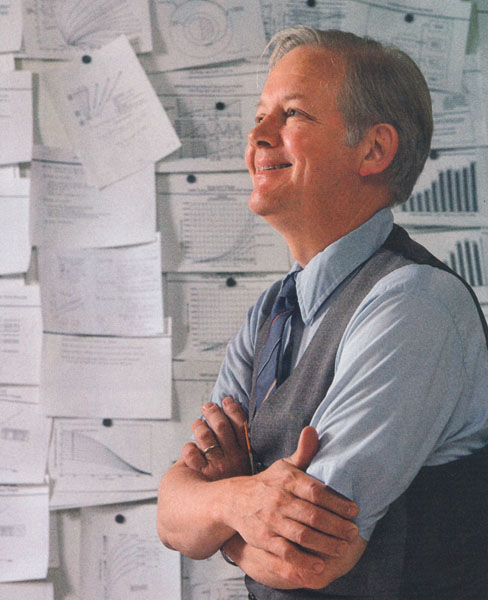
The Gordon Woodcock Space Architecture Professional Award
PURPOSE:
The Gordon Woodcock Space Architecture Professional Award recognizes the highest professional achievement of an individual in the field of space architecture.
HONORING:
This award is created in honor of Gordon Woodcock, the Boeing engineering manager who had a pioneering understanding of the value of architects in the aerospace enterprise and by his action played a key role in initiating and legitimizing the profession of Space Architecture.
The Awards is administered by the AIAA Space Architecture Technical Committee biannual and is awarded at the AIAA ASCEND Conference
AWARDEES:

2022: MARC M. COHEN
Marc M. Cohen receives the 2022 Gordon Woodcock Award for Professional Excellence in Space Architect. Dr. Cohen led the organizing effort to hold the landmark (first) Space Architecture Symposium at the 2002 World Space Congress at which the attendees established the Millennium Charter for Space Architecture. Dr. Cohen’s work intertwines with NASA’s goals and objectives, particularly for Human Exploration. His early contributions include the cupola and spherical nodes (later changed to short cylinders) for ISS, the Suitport EVA Access Facility for ISS and lunar/planetary surfaces, and the Space Station Proximity Operations Simulator. His Suitport US patent no. 4,842,224 has seen widespread adoptionin the space architecture community.

2020: A. SCOTT HOWE
A. Scott Howe receives First Gordon Woodcock Award for Professional Excellence in Space Architecture. Dr. Howe has been a space architect since 2007 and is also a licensed architect in the state of California. He works at Caltech, Jet Propulsion Laboratory, (JPL), Pasadena, California with responsibilities in systems engineering, mechanisms, mechanical design, deep space outpost design, robotic construction research, habitat design, and vehicle design.
He has earned a PhD in architecture from University of Michigan, and a second PhD in Industrial and Manufacturing Systems Engineering from Hong Kong University. In addition, he also has two Masters degrees and a Bachelor of University studies.
SELECTION CRITERIA
• Minimum of 10 years practice
• Predominately space architecture but may also include contributions to human factors and space engineering
• Significant contribution to the profession
o Concepts
o Management responsibilities
o Papers books, journals, etc.
o Professional society membership
• Commercial and academic contributions
• Additional considerations
o Terrestrial architecture
o Artwork, music, etc.
o Committees service
o AIAA membership
• Discuss potential of a posthumous award
SELECTION PROCESS
• The Space Architecture Awards Committee selects a Woodcock Award Team (four minimum)
• From the candidate pool, the Woodcock Award Team selects four candidates for the biannual award
• The Award Team
o Requests portfolio, biographic and other information from each of the four candidates
o Solicits testimonials on each of the candidates
o Meets to discuss and vote on a winner
o Confirm the winner’s attendance at the award ceremony
• The chair of the Award Team coordinates the ceremony with AIAA Conference leaders
GORDON WOODCOCK BIOGRAPHY
Gordon R. Woodcock is a retired Boeing engineering manager, former President of the L5 Society, and former Chairman of the NSS Executive Committee. He has 59 years experience in aerospace engineering, and has published over 100 technical papers and articles including some co-authored with Dr. Wernher von Braun. He has worked for Boeing, NASA, Space America, and Gray Research consulting on flight simulation development, propulsion, and mission architecture. Woodcock’s publications include the books Space Stations & Platforms and Space Exploration: Mission Engineering and articles by Mr. Woodcock can be found in Resources of Near Earth Space and Solar Power Satellites, and New Destinies: The Paperback Magazine, Volume VII / Spring 1989, among others.
Woodcock has served on several NASA advisory and review committees throughout the latter decades of the 20th century.
• B.S. Aeronautical Engineering, Oregon State, 1954
• Joined Boeing 1954 as a test & technology engineer on ramjet & rocket propulsion R&D with the Bomarc & Minuteman programs. Assigned to Boeing Saturn I-C development team in Huntsville, AL.
• Worked for NASA at Marshall SFC in the Future Projects Office on assignments including lunar & planetary missions, launch vehicles, and propulsion, 1963-1968.
• M.S. Nuclear Engineering, University of Washington, 1965.
• Rejoined Boeing on the Apollo technical integration program in Washington, D.C.
• Returned to Seattle 1969 to work on the space shuttle preliminary design & upper stage preliminary design.
• Managed design study contracts for NASA 1974+ including: Future Space Transportation, Solar Power Satellites, The Space Operations Center (ISS precursor), and several space station Phase-A & technology studies.
• Key member of winning Boeing space station Phase-B proposal team. Served as Laboratory Module outfitting manager during part of Boeing’s Phase-B space station Program. Assigned as design strategy manager for the winning Phase C/D space station proposal.
• Manager of Future Studies Office for Boeing’s Advanced Civil Space Systems program in Huntsville, AL; responsible for preliminary design of manned lunar & Mars exploration systems 1987+.
• Retired from Boeing 1996.
